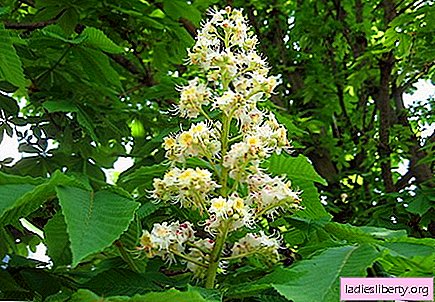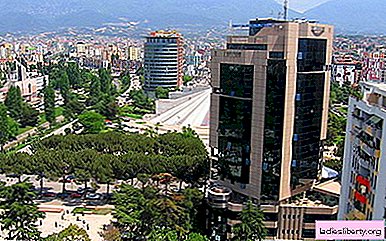
Chestnut - a general description
Chestnut (Castánea) is a monoecious, deciduous tree or shrub of the Beech family, about 50 m high. The trunk has a deep furrowed, brownish-brown thick bark. The leaves are spiral-double-row, short-leaved, broad-lanceolate, at the apex in the form of a pointed wedge or heart. Thin earrings of 5-15 cm, which contain mainly stamen flowers, pistillate are separately near the base.
Seeds grow in the form of triangular spherical wavy cotyledons with a large white germ, they contain a large amount of starch. In a thin leathery shell of nuts with narrowing upward, the remains of perianth and columns are located. The nuts themselves are ovoid-spherical in contact with each other with flat sides. When collecting pollen and nectar, a plant pollinates many insects.
Chestnut - types and places of growth
There are 10 types of chestnut (stunted, European, American, small town, Segu, etc.) Despite the fact that this tree prefers a warm and temperate climate, it can be found in various areas of East Asia, the Mediterranean and the Atlantic coast of the United States. Chestnut does not tolerate dry and swampy soils, on the slopes of the mountains it can be found in the shaded places of unknown limestone rocks.
Horse chestnut (wild) is slightly different from edible chestnut, it can be found in the Balkans, it has been considered European culture since the 16th century. At any age, the plant is distinguished by a fairly rapid growth and a large number of shoots from a stump. In Russia and Ukraine, chestnut can be found in the southern regions, it is considered a symbol of Kiev. This ornamental plant adorns many parks and squares in cities.
Chestnut - healing properties
The painkillers, venotonic and antithrombotic properties of this plant are widely used in homeopathy for the treatment of many diseases. Official medicine has a whole list of medicines based on certain types of chestnut.
An approximate list of diseases that a chestnut remedy can help may look like this: malaria, diarrhea, increased acidity of gastric juice, bronchitis, uterine bleeding, vasospasm, neuralgia, violation of the secretion of bile, pulmonary tuberculosis, gastritis, leg veins, acute and chronic thrombophlebitis, arteritis, venous congestion, thromboembolism of small vessels. Chestnut is a good honey plant, which abundantly produces nectar, pollen and glue, and has the ability to clean the air of exhaust gases.
Chestnut - dosage forms
Traditional medicine for medicinal purposes can use chestnut fruits, flowers, leaves and bark. Flower juice and ripe seeds are also used. Bark is harvested in the spring after pruning, spreading it for drying in aerated semi-open rooms. Leaves can be harvested during spring and summer, but preferably at the end of the season, before yellowing.
Ripe seeds are dried in dryers or sprinkled with a layer of 5 cm on racks. In pharmacology, the action of chestnut is due to the incorporation of glycosides, esculin and escin, into its composition, which lower the viscosity of the blood and slow its coagulation.
In the pharmaceutical industry, several drugs are produced that are made from the fruits of horse chestnut, bark and its leaves. Aescusan (Aescusanum) is produced in Germany, used for stagnation of veins and the expansion of venous blood flow in the legs. Esflazid (Aesflazidum) contains escin and flavonoids, is available in tablets, and is used for phlebitis and thrombophlebitis. Anavenol (Anavenol) - dragee containing eculin, rutin and sodium sulfone, this tool is used for diseases of the veins.
Chestnut - recipes
- Chestnut flower juice: take 20-25 drops of juice, per tablespoon of honey 3 times a day before meals.
Medicine for the treatment of inflammation of the veins and hemorrhoids (decoction of fruits and leaves of a chestnut): pour 5 grams of fruits and 5 grams of leaves pour 200 ml of boiling water, keep in a sealed enameled container in a water bath for half an hour, strain while hot, bring to the original volume. With hemorrhoids, the duration of treatment is 1-4 weeks, with venous inflammation - 2-8 weeks. Take 1 tbsp. spoon before eating.
Chestnut - contraindications
Horse chestnut preparations should be used by monitoring blood prothrombin under the supervision of doctors.
Comments











